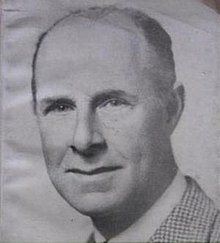Loading AI tools
French biophysicist and philosopher (1883–1947) From Wikipedia, the free encyclopedia
Pierre Lecomte du Noüy (French pronunciation: [ləkɔ̃t dy nwi];[1] 20 December 1883 – 22 September 1947) was a French biophysicist and philosopher. He is probably best remembered by scientists for his work on the surface tension, and other properties, of liquids.
Pierre Lecomte du Noüy | |
|---|---|
 | |
| Born | December 20, 1883 |
| Died | September 22, 1947 (aged 63) |
| Known for | Du Noüy ring tensiometer Du Noüy ring method Telefinalist hypothesis |
| Scientific career | |
| Fields | Biophysics |
| Institutions | Rockefeller Institute Pasteur Institute |
Du Noüy was a descendant of the French dramatist Pierre Corneille. His mother, Hermine Lecomte du Noüy, wrote many novels, one of which, Amitié Amoureuse, was translated into 16 languages and ran for 600 editions in France.
Born and educated in Paris, France, du Noüy obtained the degrees of LL.B., Ph.B., Sc.B., Ph.D., and Sc.D.
He was an associate member of the Rockefeller Institute working in Alexis Carrel's lab from 1920 through 1928, head for 10 years of the biophysics division of the Pasteur Institute,[2] and the author of some 200 published papers.[3]
He invented a tensiometer,[4] a scientific apparatus that used his du Noüy ring method to measure the surface tension of liquids.[5]
Du Noüy believed that mankind should have confidence in science, but be aware that we know less about the material world than is commonly believed.
Du Noüy converted from agnosticism to Christianity. He supported a theistic and teleological interpretation of evolution.[6] In his book Human Destiny he wrote that biological evolution continues to a spiritual and moral plane.[6] Du Noüy met Pierre Teilhard de Chardin who shared similar interests in evolution and spirituality.[7]
Du Noüy developed his own hypothesis of orthogenesis known as "telefinalism".[8] According to Du Noüy evolution could not occur by chance alone and that on an average since "the beginning of the world it has followed an ascending path, always oriented in the same direction." He accepted naturalistic evolutionary mechanisms such as mutation and natural selection but believed science could not explain all evolutionary phenomena or the origin of life.[9] According to his telefinalist hypothesis a transcendent cause which he equated with God is directing the evolutionary process.[6]
His "telefinalist" hypothesis was criticized by Carl Hempel,[10] Leo Koch and George Gaylord Simpson as nonscientific.[6][11]

If telefinalism, by postulating the intervention of an Idea, a Will, a supreme Intelligence, throws a little light on the combined transformations leading through an uninterrupted line to Man, it seems impossible not to see in the particular transformations limited to the species something more than the simple play of physico-chemical forces and chance. Human Destiny, p. 97
Seamless Wikipedia browsing. On steroids.
Every time you click a link to Wikipedia, Wiktionary or Wikiquote in your browser's search results, it will show the modern Wikiwand interface.
Wikiwand extension is a five stars, simple, with minimum permission required to keep your browsing private, safe and transparent.